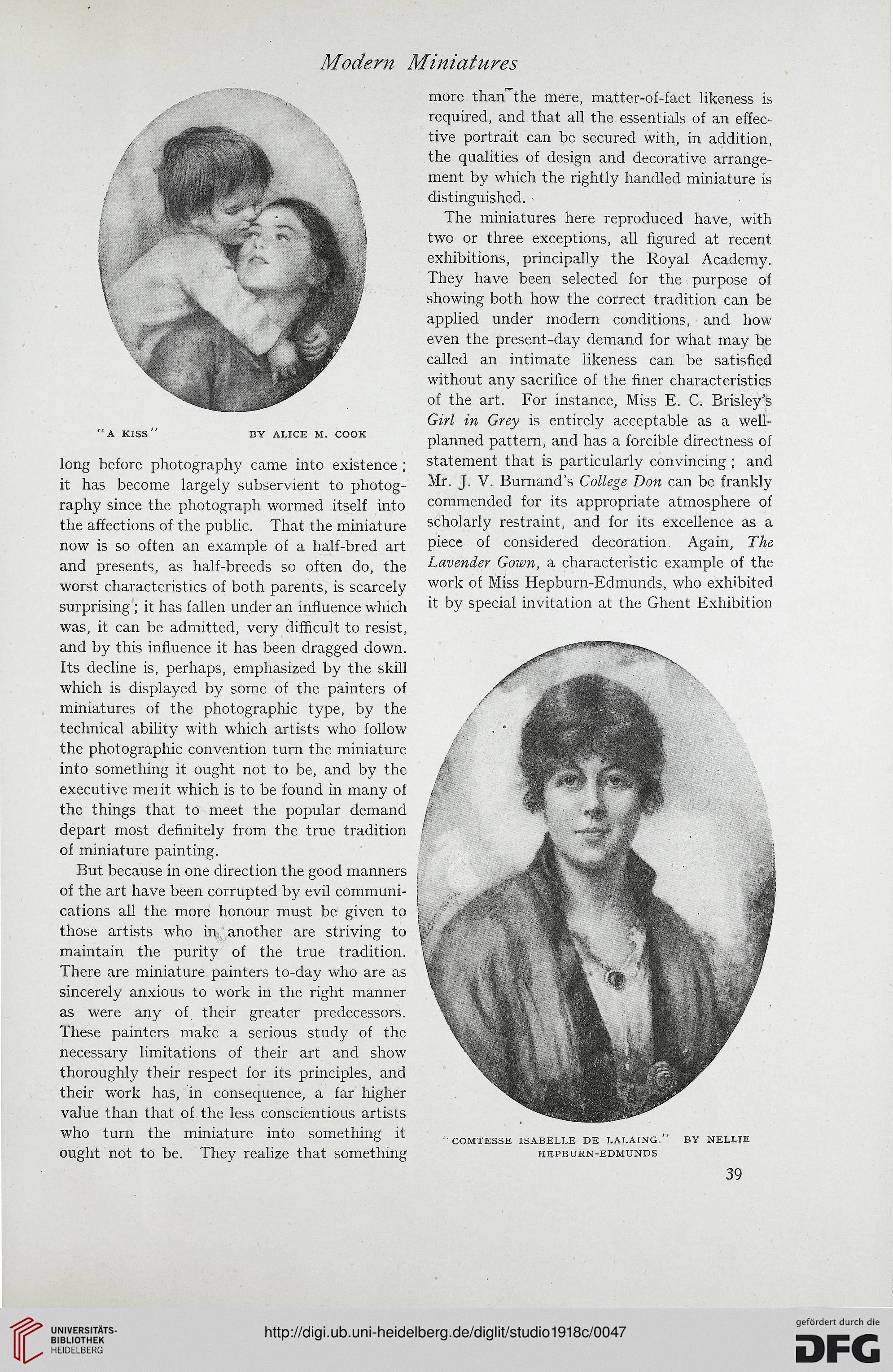Modern Miniatures
"A KISS" BY ALICE M. COOK
long before photography came into existence ;
it has become largely subservient to photog-
raphy since the photograph wormed itself into
the affections of the public. That the miniature
now is so often an example of a half-bred art
and presents, as half-breeds so often do, the
worst characteristics of both parents, is scarcely
surprising; it has fallen under an influence which
was, it can be admitted, very difficult to resist,
and by this influence it has been dragged down.
Its decline is, perhaps, emphasized by the skill
which is displayed by some of the painters of
miniatures of the photographic type, by the
technical ability with which artists who follow
the photographic convention turn the miniature
into something it ought not to be, and by the
executive meiit which is to be found in many of
the things that to meet the popular demand
depart most definitely from the true tradition
of miniature painting.
But because in one direction the good manners
of the art have been corrupted by evil communi-
cations all the more honour must be given to
those artists who in another are striving to
maintain the purity of the true tradition.
There are miniature painters to-day who are as
sincerely anxious to work in the right manner
as were any of their greater predecessors.
These painters make a serious study of the
necessary limitations of their art and show
thoroughly their respect for its principles, and
their work has, in consequence, a far higher
value than that of the less conscientious artists
who turn the miniature into something it
ought not to be. They realize that something
more than~the mere, matter-of-fact likeness is
required, and that all the essentials of an effec-
tive portrait can be secured with, in addition,
the qualities of design and decorative arrange-
ment by which the rightly handled miniature is
distinguished.
The miniatures here reproduced have, with
two or three exceptions, all figured at recent
exhibitions, principally the Royal Academy.
They have been selected for the purpose of
showing both how the correct tradition can be
applied under modern conditions, and how
even the present-day demand for what may be
called an intimate likeness can be satisfied
without any sacrifice of the finer characteristics
of the art. For instance, Miss E. C. Brisley's
Girl in Grey is entirely acceptable as a well-
planned pattern, and has a forcible directness of
statement that is particularly convincing ; and
Mr. J. V. Burnand's College Don can be frankly
commended for its appropriate atmosphere of
scholarly restraint, and for its excellence as a
piece of considered decoration. Again, The
Lavender Gown, a characteristic example of the
work of Miss Hepburn-Edmunds, who exhibited
it by special invitation at the Ghent Exhibition
COMTESSE ISABELLE DE LALAING." BY NELLIE
HEPBURN-EDMUNDS
39
"A KISS" BY ALICE M. COOK
long before photography came into existence ;
it has become largely subservient to photog-
raphy since the photograph wormed itself into
the affections of the public. That the miniature
now is so often an example of a half-bred art
and presents, as half-breeds so often do, the
worst characteristics of both parents, is scarcely
surprising; it has fallen under an influence which
was, it can be admitted, very difficult to resist,
and by this influence it has been dragged down.
Its decline is, perhaps, emphasized by the skill
which is displayed by some of the painters of
miniatures of the photographic type, by the
technical ability with which artists who follow
the photographic convention turn the miniature
into something it ought not to be, and by the
executive meiit which is to be found in many of
the things that to meet the popular demand
depart most definitely from the true tradition
of miniature painting.
But because in one direction the good manners
of the art have been corrupted by evil communi-
cations all the more honour must be given to
those artists who in another are striving to
maintain the purity of the true tradition.
There are miniature painters to-day who are as
sincerely anxious to work in the right manner
as were any of their greater predecessors.
These painters make a serious study of the
necessary limitations of their art and show
thoroughly their respect for its principles, and
their work has, in consequence, a far higher
value than that of the less conscientious artists
who turn the miniature into something it
ought not to be. They realize that something
more than~the mere, matter-of-fact likeness is
required, and that all the essentials of an effec-
tive portrait can be secured with, in addition,
the qualities of design and decorative arrange-
ment by which the rightly handled miniature is
distinguished.
The miniatures here reproduced have, with
two or three exceptions, all figured at recent
exhibitions, principally the Royal Academy.
They have been selected for the purpose of
showing both how the correct tradition can be
applied under modern conditions, and how
even the present-day demand for what may be
called an intimate likeness can be satisfied
without any sacrifice of the finer characteristics
of the art. For instance, Miss E. C. Brisley's
Girl in Grey is entirely acceptable as a well-
planned pattern, and has a forcible directness of
statement that is particularly convincing ; and
Mr. J. V. Burnand's College Don can be frankly
commended for its appropriate atmosphere of
scholarly restraint, and for its excellence as a
piece of considered decoration. Again, The
Lavender Gown, a characteristic example of the
work of Miss Hepburn-Edmunds, who exhibited
it by special invitation at the Ghent Exhibition
COMTESSE ISABELLE DE LALAING." BY NELLIE
HEPBURN-EDMUNDS
39




